新目标英语七年级上册Unit5教学设计
- 格式:doc
- 大小:149.50 KB
- 文档页数:4
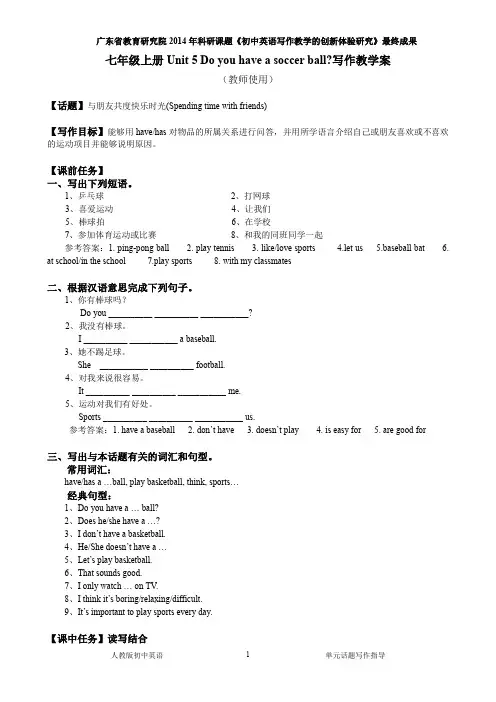
七年级上册Unit 5 Do you have a soccer ball?写作教学案(教师使用)【话题】与朋友共度快乐时光(Spending time with friends)【写作目标】能够用have/has对物品的所属关系进行问答,并用所学语言介绍自己或朋友喜欢或不喜欢的运动项目并能够说明原因。
【课前任务】一、写出下列短语。
1、乒乓球2、打网球3、喜爱运动4、让我们5、棒球拍6、在学校7、参加体育运动或比赛8、和我的同班同学一起参考答案:1. ping-pong ball 2. play tennis 3. like/love sports 4.let us 5.baseball bat 6. at school/in the school 7.play sports 8. with my classmates二、根据汉语意思完成下列句子。
1、你有棒球吗?Do you __________ __________ ___________?2、我没有棒球。
I __________ ___________ a baseball.3、她不踢足球。
She ___________ __________ football.4、对我来说很容易。
It __________ __________ ___________ me.5、运动对我们有好处。
Sports __________ __________ ___________ us.参考答案:1. have a baseball 2. don’t have 3. doesn’t play 4. is easy for 5. are good for三、写出与本话题有关的词汇和句型。
常用词汇:have/has a …ball, play basketball, think, sports…经典句型:1、Do you have a … ball?2、Does he/she have a …?3、I don’t have a basketball.4、He/She doesn’t have a …5、Let’s play basketball.6、That sounds good.7、I only watch … on TV.8、I think it’s boring/relaxing/difficult.9、It’s important to play sports every day.【课中任务】读写结合一、A. 信息归纳阅读下面短文,然后按照项目要求填写所缺信息。
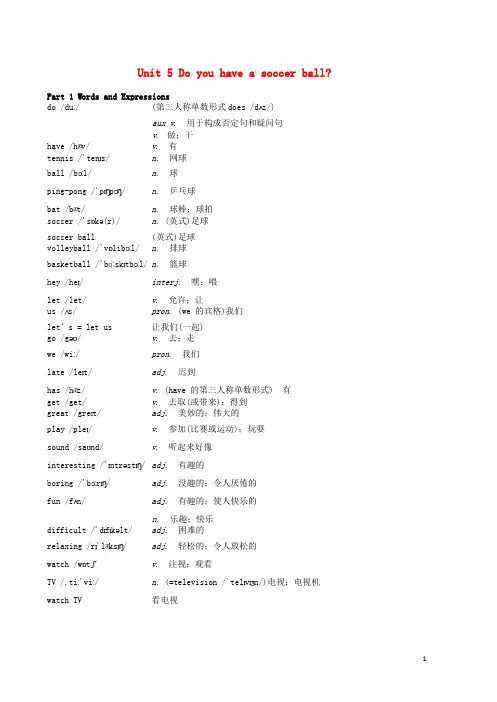
Unit 5 Do you have a soccer ball?Part 1 Words and Expressionsdo /duː/ (第三人称单数形式does /dʌz/)aux v. 用于构成否定句和疑问句v. 做;干have /hæv/ v. 有tennis /'tenɪs/ n. 网球ball /bɔːl/ n. 球ping-pong /'pɪŋpɔŋ/ n. 乒乓球bat /bæt/ n. 球棒;球拍soccer /'sɒkə(r)/ n. (英式)足球soccer ball (英式)足球volleyball /'vɒlibɔːl/ n. 排球basketball /'bɑːskɪtbɔːl/ n. 篮球hey /heɪ/ interj. 嘿;喂let /let/ v. 允许;让us /ʌs/ pron. (we 的宾格)我们let’s = let us 让我们(一起)go /gəʊ/ v. 去;走we /wiː/ pron. 我们late /leɪt/ adj. 迟到has /hæz/ v. (have 的第三人称单数形式) 有get /get/ v. 去取(或带来);得到great /greɪt/ adj. 美妙的;伟大的play /pleɪ/ v. 参加(比赛或运动);玩耍sound /saʊnd/ v. 听起来好像interesting /'ɪntrəstɪŋ/ adj. 有趣的boring /'bɔːrɪŋ/ adj. 没趣的;令人厌倦的fun /fʌn/ adj. 有趣的;使人快乐的n. 乐趣;快乐difficult /'dɪfɪkəlt/ adj. 困难的relaxing /rɪ'læksɪŋ/ adj. 轻松的;令人放松的watch /wɒtʃ/ v. 注视;观看TV /,tiː'viː/ n. (=television /'telɪvɪʒn/)电视;电视机watch TV 看电视same /seɪm/ adj. 相同的love /lʌv/ v. & n. 爱;喜爱with /wɪð/ prep. 和……在一起;带有;使用sport /spɔː(r)t/ n. 体育运动them /ðəm/ pron. (they 的宾格) 他(她、它)们only /'əʊnli/ adv. 只;仅like /laɪk/ v. 喜欢;喜爱easy /'iːzi/ adj. 容易的;不费力的after /'ɑːftə(r)/ prep. & conj. 在……之后class /klɑːs/ n. 班级;课classmate /'klɑːsmeɪt/ n. 同班同学Bill /bɪl/ 比尔(男名)Part 2:Texts课文(一)Cindy: Hey, Helen, let’s go! We’re late!Helen: OK.Cindy: Do you have the baseball?Helen: Yes, I do. It’s in my bag.Cindy: And where’s our baseballbat? Helen: Bill has it.Cindy: Oh, yeah. And do you have your jacket?Helen: Oh, no, I don’t. It’s on the chair. Letme get it. Cindy: And your hat, too!Helen: OK, I have my jacket and hat. Let’s go!Structure1. Do you have a baseball?Yes, I do./No, I don’t. I have a volleyball.2. Do you have a ping-pong bat?Yes, I do./No, I don’t. I have a ping-pong ball.3. Does she have a tennis ball?Yes, she does./No, she doesn’t. She has a baseball.4. Does he have a soccer ball?Yes, he does./No. he doesn’t. He has two ping-pong bats.5. Do they have a basketball?Yes, they do./No, they don’t. They have a volleyball.don’t = do not doesn’t = does not句型:—Do/Does sb. have…?—Yes, sb. do / does.—No, sb. don’t / doesn’t.Write each word in the correct place in the chart.将方框中的单词填入表格中正确的位置。
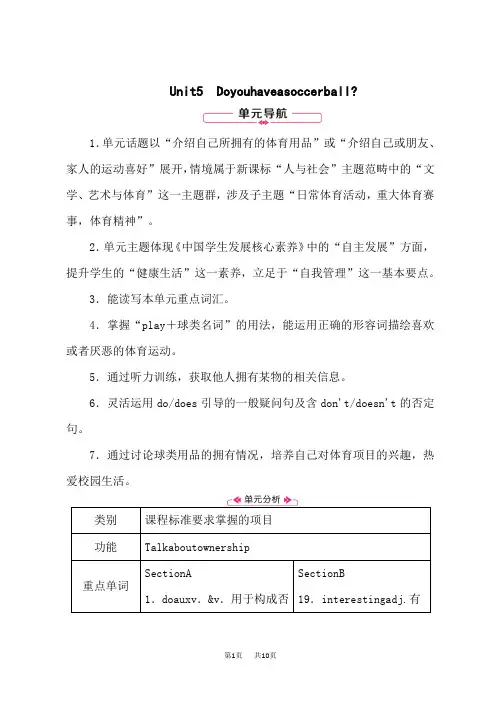
Unit5 Doyouhaveasoccerball?1.单元话题以“介绍自己所拥有的体育用品”或“介绍自己或朋友、家人的运动喜好”展开,情境属于新课标“人与社会”主题范畴中的“文学、艺术与体育”这一主题群,涉及子主题“日常体育活动,重大体育赛事,体育精神”。
2.单元主题体现《中国学生发展核心素养》中的“自主发展”方面,提升学生的“健康生活”这一素养,立足于“自我管理”这一基本要点。
3.能读写本单元重点词汇。
4.掌握“play+球类名词”的用法,能运用正确的形容词描绘喜欢或者厌恶的体育运动。
5.通过听力训练,获取他人拥有某物的相关信息。
6.灵活运用do/does 引导的一般疑问句及含don't/doesn't 的否定句。
7.通过讨论球类用品的拥有情况,培养自己对体育项目的兴趣,热爱校园生活。
续表【课时建议】本单元建议5课时SectionA(1a-1c)(一课时)SectionA(2a-2d)(一课时)SectionA(GrammarFocus-3c)(一课时)SectionB(1a-1d)(一课时)SectionB(2a-SelfCheck)(一课时)词汇短语:主要采用图片及多媒体展示助记法。
基本句子:采用多媒体展示及交际法(利用多媒体展示两人进行交际时的情景)。
语法:就本单元话题“The sporting goods they own”运用一般疑问句谈论物品所属关系,采用freetalk加深印象。
第一课时SectionA (1a-1c)Step1 情景导入【参考案例】T:Lookatthesportsthings.Here,thepingpongballismine.Itbel ongstome.SoIhaveapingpongball.“Have”isan importantverbinthisunit.Nowlistencarefully:Doyouhaveapingpongball?I'maskingyouifyouhaveapingpongball.Ifyouhave,say“Yes,Ido.”;ifnot,say“No,Idon't.”设计意图:通过提问引出本课的语言目标,在师生问答中自然而然导入新课。
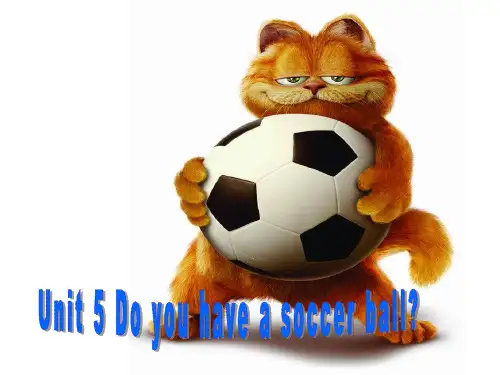
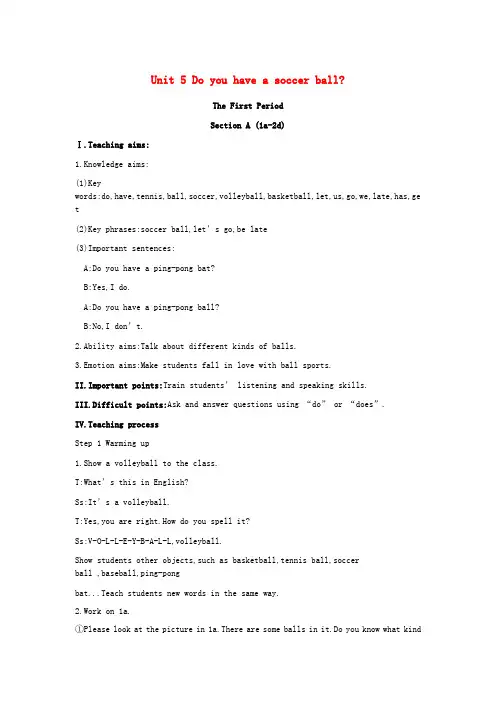
Unit 5 Do you have a soccer ball?The First PeriodSection A (1a-2d)Ⅰ.Teaching aims:1.Knowledge aims:(1)Keywords:do,have,tennis,ball,soccer,volleyball,basketball,let,us,go,we,late,has,ge t(2)Key phrases:soccer ball,let’s go,be late(3)Important sentences:A:Do you have a ping-pong bat?B:Yes,I do.A:Do you have a ping-pong ball?B:No,I don’t.2.Ability aims:Talk about different kinds of balls.3.Emotion aims:Make students fall in love with ball sports.II.Important points:Train students’ listening and speaking skills.III.Difficult points:Ask and answer questions using “do” or “does”.IV.Teaching processStep 1 Warming up1.Show a volleyball to the class.T:What’s this in English?Ss:It’s a volleyball.T:Yes,you are right.How do you spell it?Ss:V-O-L-L-E-Y-B-A-L-L,volleyball.Show students other objects,such as basketball,tennis ball,soccerball ,baseball,ping-pongbat...Teach students new words in the same way.2.Work on 1a.①Please look at the picture in 1a.There are some balls in it.Do you know what kindof balls theyare?Match the words with the things in the picture.②Teacher checks the answers.③Look at the key structure.—Do you have a ping-pong bat?—Yes,I do.—Do you have a ping-pong ball?—No,I don’t.Read the words and dialogue after the teacher and then read it together.Step 2 ListeningWork on 1b,2a,2b.1.Play the recording for the first time.Students only listen.2.Play the recording again and ask students to do 1b,2a,2b.3.Check the answers in 1b,2a,2b.Step 3 PairworkWork on 1c.Practice the conversation with your partner. Then ask and answer questions about the things in 1a.A: Do you have a ping-pong bat?B: Yes,I do.A: Do you have a ping-pong ball?B: No,I don’t.Work on 2c.Ask and answer questions about the people in 2a.A:Does Jane have a tennis ball?B:No,she doesn’t.Ask some pairs to act out their conversation.Step 4 Role-playWork on 2d.Let students read the conversation after the teacher,and then practice the conversation with theirpartners.Teacher asks some pairs to act out the conversation in front of the class.Language points1.have的用法(1)have为实义动词,意为“有”,常用句型为sb. have/has +sth.,表示“某人有某物”,当主语为第三人称单数时,have用其单三形式has。
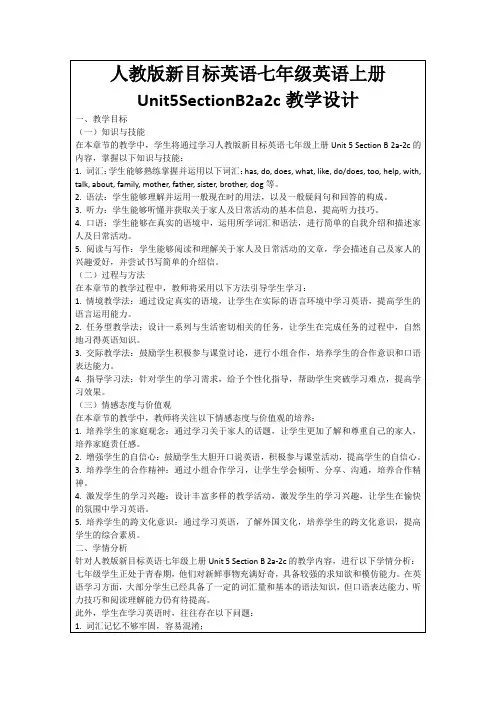
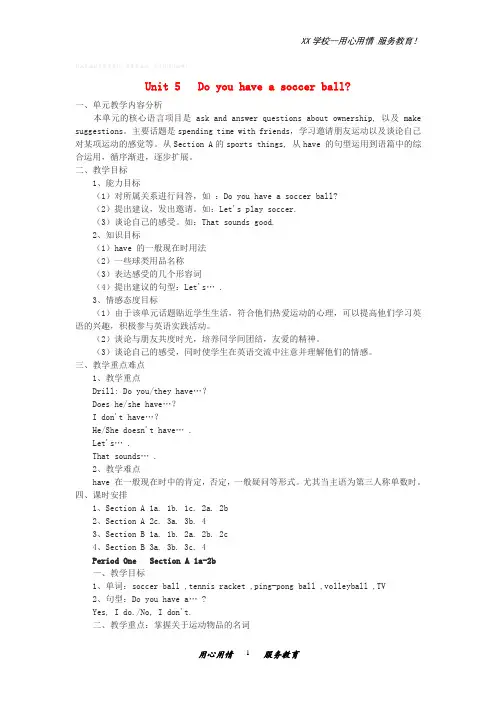
精品基础教育教学资料,请参考使用,祝你取得好成绩!Unit 5 Do you have a soccer ball?一、单元教学内容分析本单元的核心语言项目是ask and answer questions about ownership, 以及make suggestions。
主要话题是spending time with friends,学习邀请朋友运动以及谈论自己对某项运动的感觉等。
从Section A的sports things, 从have 的句型运用到语篇中的综合运用,循序渐进,逐步扩展。
二、教学目标1、能力目标(1)对所属关系进行问答,如:Do you have a soccer ball?(2)提出建议,发出邀请。
如:Let's play soccer.(3)谈论自己的感受。
如:That sounds good.2、知识目标(1)have 的一般现在时用法(2)一些球类用品名称(3)表达感受的几个形容词(4)提出建议的句型:Let's… .3、情感态度目标(1)由于该单元话题贴近学生生活,符合他们热爱运动的心理,可以提高他们学习英语的兴趣,积极参与英语实践活动。
(2)谈论与朋友共度时光,培养同学间团结,友爱的精神。
(3)谈论自己的感受,同时使学生在英语交流中注意并理解他们的情感。
三、教学重点难点1、教学重点Drill: Do you/they have…?Does he/she have…?I don't have…?He/She doesn't have… .Let's… .That sounds… .2、教学难点have 在一般现在时中的肯定,否定,一般疑问等形式。
尤其当主语为第三人称单数时。
四、课时安排1、Section A 1a. 1b. 1c. 2a. 2b2、Section A 2c. 3a. 3b. 43、Section B 1a. 1b. 2a. 2b. 2c4、Section B 3a. 3b. 3c. 4Period One Section A 1a-2b一、教学目标1、单词:soccer ball ,tennis racket ,ping-pong ball ,volleyball ,TV2、句型:Do you have a… ?Yes, I do./No, I don't.二、教学重点:掌握关于运动物品的名词三、教学难点:学会使用句型Do you have a… ? Yes, I do./No, I don't.四、教学设计Step1 Warming up:使用所学句型进行快速问答,激发学生快速反应和应变能力。
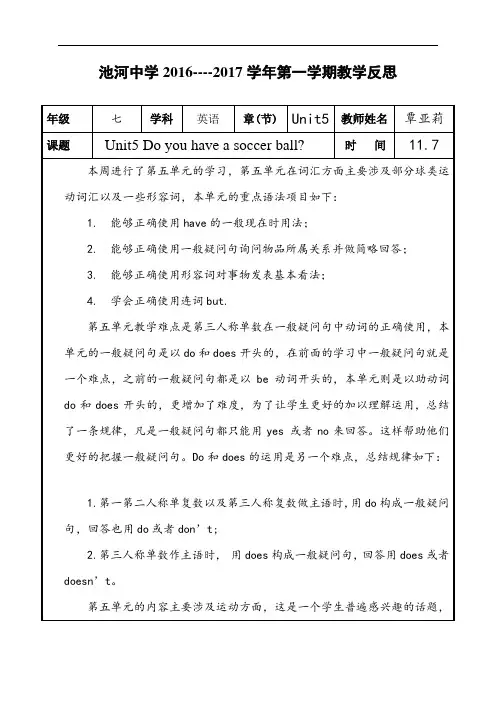
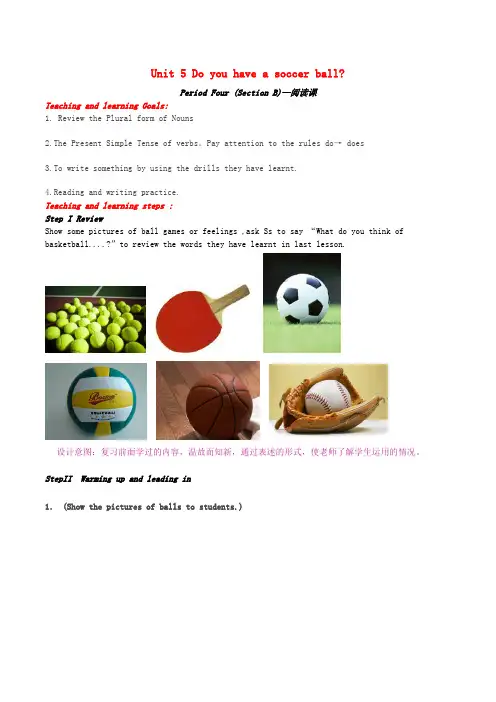
Unit 5 Do you have a soccer ball?Period Four (Section B)—阅读课Teaching and learning Goals:1. Review the Plural form of Nouns2.The Present Simple Tense of verbs。
Pay attention to the rules do→ does3.To write something by using the drills they have learnt.4.Reading and writing practice.Teaching and learning steps :Step I ReviewShow some pictures of ball games or feelings ,ask Ss to say “What do you think of basketball....?”to review the words they have learnt in last lesson.设计意图:复习前面学过的内容,温故而知新,通过表述的形式,使老师了解学生运用的情况。
StepII Warming up and leading in1.(Show the pictures of balls to students.)tennis racket s basketball sping-pong ball s and bat sT: I have two tennis rackets, three basketballs and four ping-pong balls and bats.This is my sports collection.(Repeat the collection several times and teach the new word.)T: What about you?(Ask some students to say something about their own collections.)S: I have three…2. T: I don’t have a soccer ball . Do you have a soccer ball ?Ss: Yes, I do./ No, I don’t.T: Let’s look at the three students. Frank Brown, Gina Smith, Wang Wei.Do they have a soccer ball?设计意图:利用学生的切身体会和实际情况引入新课,容易引起学生的关注,同时在复习过程中对名词的复数进行了复习。
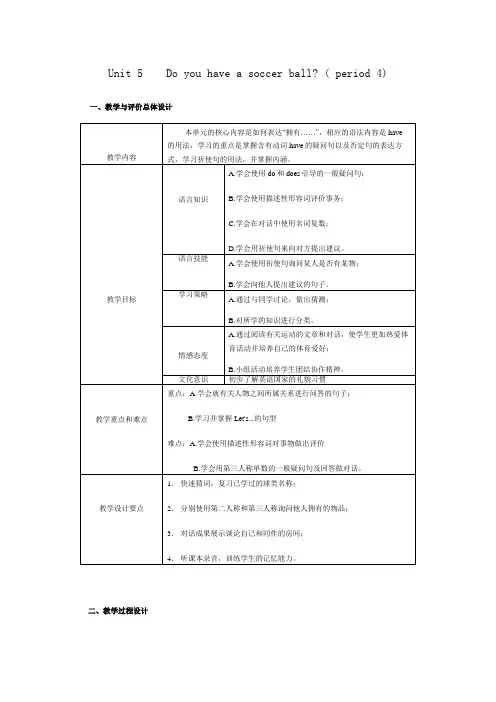
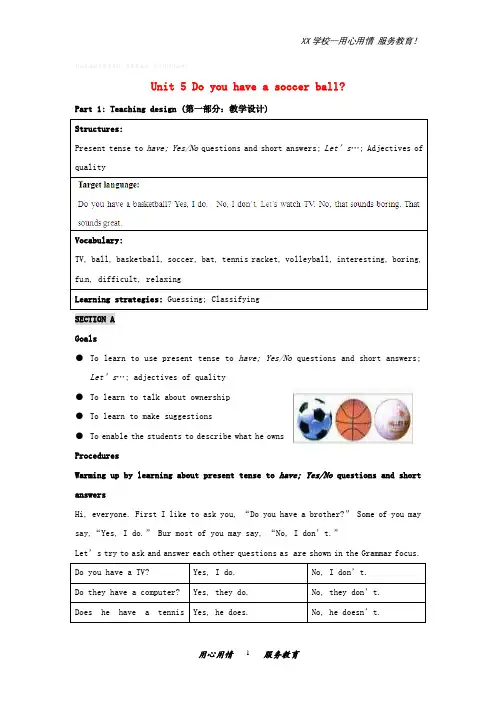
精品基础教育教学资料,请参考使用,祝你取得好成绩!Unit 5 Do you have a soccer ball?Part 1: Teaching design (第一部分:教学设计)Structures:Present tense to have; Yes/No questions and short answers; Let’s…; Adjectives of qualityVocabulary:TV, ball, basketball, soccer, bat, tennis racket, volleyball, interesting, boring, fu n, difficult, relaxingLearning strategies: Guessing; ClassifyingSECTION AGoals●To learn to use present tense to have; Yes/No questions and short answers;Let’s…; a djectives of quality●To learn to talk about ownership●To learn to make suggestions●To enable the students to describe what he ownsProceduresWarming up by learning about present tense to have; Yes/No questions and short answersHi, everyone. First I like to ask you, “Do you have a brother?” Some of you may say,“Yes, I do.” Bur most of you may say, “No, I don’t.”Let’s try to ask and answer each other questions as are shown in the Grammar focus. Do you have a TV? Yes, I do. No, I don’t.Do they have a computer? Yes, they do. No, they don’t.Does he have a tennis Yes, he does. No, he doesn’t.racket?Yes, she does. No, she doesn’t.Does she have a soccerball?Yes, he does. No, he doesn’t.Doe Chi-Yong have aba seball?Do you have a bookcase? Yes, I do. No, I don’t.Do they have a cassette? Yes, they do. No, they don’t.Does he have a computer? Yes, he does. No, he doesn’t.Does she have a hamburger? Yes, she does. No, she doesn’t.Yes, he does. No, he doesn’t.Doe Chi-Yong have avolleyball?Warming up by greetingHello, everyone!Today we shall take up unit 5. The title of this unit is Do you have a soccer ball? Look, here are some balls on the desk. Can you name them? What’s this?Yes, it’s a basketball.This is my basketball .I have a basketball. Say after me, I have a basketball.Good! Do you have a basketball?Repeat after me, Do you have a basketball? Good! Maybe some students will say, Yes, I, do. Others will say, No, I don’t. Repeat please. Now let’s talk about the other balls. Read the following sentences after me.He has a soccer ball.Does he have a soccer ball? Yes, he does.She has a volleyball.Does she have a volleyball? No, she doesn’t.1a Matching the words with the picturesPlease look at the picture on page 25. What can you see? We can see a tennis racket, a ping-pong ball, a soccer ball, a volley, a basketball, and a TV. Now focus your attention on the word list, number1 is c, tennis racket.Please match the words and picture.1b Listening and circlingYou are great! Now please look at the four items in the list in1b and read them. I’ll play the recording twice. Please listencarefully and circle the words you hear.1c Doing pairworkNow please read the conversation in the box in 1b and practice in pairs. You can use various objects from the illustration to make your own conversations. When you practice, ple ase pay attention to thepronunciation and intonation. I’ll offer vocabulary andpronunciation support if you need.The sample:S1:Do you have a tennis racket? S2: No, I don’t.S1: Do you have a ping-pong bat? S2:Yes, I do.2a Listening and numberingNow let’s go to page 26. Please look at these four pictures and we’ll hear the conversations in the pictures. Listen carefully and number the pictures (1-4). 2b Listening and matchingYou have heard the conversations twice and have got to knowwhat people are talking about in each picture. Listen tothe recording again and write the numbers from thepictures in 2a next to the correct balls.Read the tapescript to darken present tense to have; Yes/No questions and short answers and Let’s structure.2c Doing a pairworkNow look at the picture in 2a and 2b on page 26. Please practice the conversations with your partner.2d Role-playPlease read the conversation in 2d with you partner. Then perform it in the class.Closing down by discussing the main points★Do you have s baseball? --- Yes, I do.★Does he have a tennis racket? ---No, he doesn’t.★Let’s play volleyball. ---That sounds good.3a & 3b Fill the blanksDistinguish the use of do with does. Write the word in the correct place in the chart 3a and work on 3b.3c PairworkLook at the picture of Bob’s room. Make a conversation with your partner to ask the things he has.SECTION BGoals●To learn to use some adjectives to describe sports●To write an short passage about what you ownProcedures1a MatchingWarming up by greetingWelcome back to the English class. I think most of you like sports. Some students like the soccer ball, the others like ping-pong ball, and still others maybe like basketball. Why? Because you have your own likes and dislikes. Today we’ll learn some new words to describe the sports.1a MatchingHere on page 28 are five words in 1a. Let’s see if they canexpress your feeling about sports and other things. Read themloudly and match each picture with one of the words.1b Listening and checkingLook at t he five words again. Next we’ll listen to a conversation. When you hearthe word of them in the conversation, put a checkmark to the left of each word in 1a. I’ll play the recording twice, listen carefully please.1c Listening and writingFrom the conversation above we got to know about the four activities they mentioned. And we know that they have decided to play basketball at last. What does Tony say about each activity? Listen to the conversation again and write in the word on the blank line next to each activity.1d Doing pairworkNow practice the dialogue in pairs. One student plays Paul andthe other one pla ys Jenny, talking about the activities in 2b.You should read the dialogue in 2c first, and then make your own conversation.Sample dialogue:Jenny: Let’s play computer games.Paul: That is too difficult. Hmm…let’s play basketball!Jenny: That sounds fun!Jenny: Let’s play volleyball.Paul: That is too difficult. Hmm…let’s playfootball!Jenny: That sounds fun!2a Findthe sports words in the unit to fill the column.Review the sports words in the unit and write them in the correct column. Practice the phrase: “things I have” and “things I don’t have”.2b&2c Reading and CheckingLook at the picture in 2b and read the passages. Then check the following sentences in 2c .3a Write more questions about sports thingsWrite some questions about sports equipment with the sentence pattern “Do you have…?”3b Pair workExchange the questions and answers with your partner. Then ask questions in pair. 3c WritingWrite an anticle about you and your partner with but.SELF CHECK1 List all the sports you know. Write what you think of them..Review the new words about sports things and feelings.2 Complete the blanks.Practice the grammar and sentense pattern learned in this unit.英语儿歌:Row, row, row your boatRow, row, row your boat, gently down the stream.Merrily, merrily, merrily, merrily, life is but a dream.Part2: Teaching resources (第二部分:教学资源)I. Background readings —— What is sports?■A sport consists of a normal physical activity or skill carried out under a publicly agreed set of rules, and with a recreational purpose: for competition, for self-enjoyment, to attain excellence, for the development of skill, or some combination of these. A sport has physical activity, side by side competition, and a scoring system. The difference of purpose is what characterises sport, combined with the notion of individual (or team) skill or prowess.■What winter sport combines cross-country skiing with rifle marksmanship? Which pro baseball player was known as the Sultan of Swat?■Sports, athletics, racing, hunting, baseball, football, basketball, soccer, hockey, card games, etc.■Any sporting activity. Examples: Baseball, Football, Basketball, and Hockey are the most popular sports games.■Adventure Sports, Aerial Sports, Ancient Sports, Animal Sports, Business, Cheerleading, College Sports, Combat Sports, Competition, Court Sports, Field Sports, Gymnastics, History, Skating, Sports Figures, Strength Sports, TargetSports, Track and Field, Vehicle Sports, Water Sports, Winter Sports■Games that have to do with sports, such as Baseball, Soccer,American football, Boxing, Golf, Basketball, Ice hockey,Tennis, Bowling, Rugby, etc. Backyard Sports series KnockoutKings series NBA Jam series Tecmo Super Bowl series All StarBaseball 2003II. Word studies1. have 和have got英美说“有”句法不同。
新目标七年级英语上Unit 5 Do you have a soccer ball?同步学案Unit 5 Do you have a soccer ball?一、单词导航台1.boring adj. 令人厌烦的,乏味的,无聊的2.basketballn. 篮球【考点】指球类运动时,其前不加任何冠词。
3.Bath n. 洗澡:He has a bath once a week. 他每周洗一次澡。
【考点】have a bath洗澡。
【引申】Bath巴斯(英国城市);bathroom浴室,澡堂;bathrobe浴衣,bathtub浴缸。
4.V olleyball n. 排球,排球运动【记忆法】volley(球赛中在球落地前击回)+ball(球)。
【考点】play volleyball打排球。
5.Interesting adj. 有趣味的,有意思的【记忆法】interest+ing(动词的现在分词形式作形容词)。
【引申】同义词:attractive,entertaining;反义词:boring,dull。
6.Fun n. 有趣的事,说笑,娱乐:He is full of fun. 他很风趣。
【考点】make fun of取笑,开玩笑:They are making fun of the little boy. 他们和那个小男孩开玩笑。
in fun开玩笑地,非认真的:He said it in fun. 他只是说着玩的。
【引申】同义词:enjoyment,game,play。
fun-loving爱开玩笑的。
7.Difficult adj. 难的,困难的:The place is difficult to reach. 那个处所不易到达。
【考点】It is diff icult (for sb.)to do sth…(对某人来说)做……是难的:It is difficult (for me) to learn English. (对我来说)学习英语很难。
【Introduction】Writing is a fundamental skill that students need to develop inorder to communicate effectively and contribute positively insociety. New Target English series is designed to equip studentswith language and writing skills needed for academic and personal success. In this article, we will discuss a writing lesson plan for Unit 5 of the New Target English series for seventh-grade students. 【Lesson Objectives】By the end of the lesson, students will be able to:-Understand the structure of a descriptive essay-Use appropriate vocabulary and grammar to write a descriptive essay-Edit and revise their writing to improve clarity and coherence 【Materials】-New Target English Unit 5 textbook-Computers or paper and pencils-Descriptive essay graphic organizer【Procedure】1.Warm-up (5 minutes)-Ask students to brainstorm adjectives to describe a favorite place, such as a park, beach, or museum. Write their suggestions on the board.-Ask students to choose one of the places they listed and share why they enjoy it.2. Introducing the Topic (5 minutes)-Introduce the topic of the descriptive essay by explaining that they will be writing about a place that is special or memorable to them.-Explain that a descriptive essay is a type of essay that aims to create a vivid image of a person, place, or thing in the reader's mind.3. Model the Writing Process (15 minutes)-Display a graphic organizer for a descriptive essay on the board or projector.-Go through each section of the graphic organizer, explaining what information should go in each section.-Demonstrate how to fill out the graphic organizer for a chosen place, such as a hometown or vacation spot.4. Guided Writing (20 minutes)-Have students work in pairs or small groups to fill out the graphic organizer for their chosen place.-Walk around the room and provide guidance as needed.-Encourage students to use descriptive adjectives, sensory details, and figurative language to paint a clear picture of their place. 5. Independent Writing (20 minutes)-Have students use their completed graphic organizer to write a rough draft of their descriptive essay.-Encourage students to use transition words and sentence variety to improve the flow and coherence of their writing.-Remind students to check for proper spelling, grammar, and punctuation.6. Peer Editing (10 minutes)-Have students switch papers with a partner and use a peer editing checklist to provide feedback on each other's papers.-Emphasize the importance of constructive criticism and proper etiquette during peer editing.7. Revision and Final Draft (15-20 minutes)-Have students revise their essays based on their peer feedback and their own observations.-Encourage students to use a thesaurus to replace repetitive words or phrases.-Have students write a final draft of their descriptive essay to submit.8. Conclusion (5 minutes)-Have students share their essays with the class or with a small group.-Celebrate students' success in completing a descriptive essay. 【Conclusion】The New Target English series provides a comprehensive language and writing curriculum that challenges and motivates seventh-grade students. This writing lesson plan for Unit 5 helps students develop their descriptive writing skills through a structured approach that emphasizes pre-writing, drafting, editing, and revising. Students who master these skills will be better equipped to communicate their ideas and feelings effectively in writing, a key ability that will serve them well in academic and personal contexts.。
人教版义务教育教科书◎英语七年级上册Unit 5 Do you have a soccer ball?教材解读本单元主要讨论物品所属关系以及提建议;认识一些表示运动项目的名词,通过阅读有关运动的文章和对话,使我们更加热爱体育活动并培养一种适合自己的体育爱好;谈论自己喜欢哪些球类运动,不喜欢哪些球类运动及原因;学会在生活中互相询问所爱好的运动,并根据情况发出邀请。
运用所学的知识来谈论自己所拥有的体育用品和其他物品。
与朋友谈论共度时光,培养同学间团结、友爱的精神。
单元目标一、知识与技能1. 掌握本单元重点词汇:tennis ball、ping-pong bat、soccer ball、baseball bat、volleyball、get、play、sound、interesting、boring、fun、difficult、relaxing、sport、like、easy、classmate、great。
2. 掌握重点句子:(1)Do you have a ...?(2)Yes, I do./No, I don’t.(3)Does he/she have a ...?(4)Yes, he/she does./No, he/she doesn’t.(5)That sounds good.(6)I don’t have a ... , but my brother does.(7)I have two soccer balls.(8)Let’s play ...3. 掌握本单元语法:询问物品所属关系。
二、过程与方法通过听说读写等任务型活动,熟练应用所学单词和动词词组。
掌握重点句型和语法。
三、情感态度与价值观热爱体育活动并培养一种适合自己的体育爱好;在小组活动中,培养团结协作精神;学会在生活中互相询问所爱好的运动,并根据情况发出邀请。
与朋友谈论共度时光,培养同学间团结、友爱的精神。
教法导航11. 利用图片和实物调动学生的兴趣和积极性。
新人教七年级英语上册Unit5教学设计
1、教学内容
1)、词汇:,soccer,ball,tennis racket,ping-pong ball,volleyball,basketball,bat,
2)、语言结构:
Do you have a ping-pong ball?Yes,I do。
Do you have a ping-pong bat?Not,I do not。
Does she/he have a pen?Yes,she/he
does
二、教学目标
1、语言知识
词汇:A、重点掌握表示有关各种运动球类的名词, 如basketball, soccerball,so on
重点句型:? Do you/they have a TV? Yes,I/they do./No,I/they don’t.
Does he/she have a soccer ball? Yes,he/she does./No,he/she doesn’t.
2、语言技能
1)、能看着图片说;Do you/they have a TV? Yes,I/they do./No,I /they don’t.
Does he/she have a soccer ball? Yes,he/she does./No,he/she doesn’t.
3、学习策略
1)、利用老师所提供的图片卡片做出简单的判断。
2)、通过与同学交流,学会使用一般现在时的疑问形式及肯定和否定回答。
4、情感态度
1)通过各小组的对话练习培养学生的合作精神;
2)通过学习本单元,教会学生之间互相有无的主要句式
三、重点难点
1、Have 的一般现在时的疑问式用法;
2、Have的一般现在时的疑问句,及其肯定,否定回答;
3、简单拓展主语第三人称单数的句型。
教学手段:采用最简单的卡片图片、课本以及肢体语言。
理念与思路、教法
1)采用图片进行直观教学。
2)学生在课堂教学过程中口头训练应成为本单元教学的重点内容。
四、教学流程
一、lead-in
The teacher says:boys,girls,do you know the song :go go go ,olei olei olei;yeah,it’sports song.do you know about sports .so do
action.ok,let’s come to game show .
二、word study
do the action of playing basketball,the students may say篮球,yeah! Basketball,let’s read it three
times ,basketball ,basketball ,basketball.very good ! do the action of playing volleyball, the students may say排球,yeah! Volleyball, let’s read it three times , Volleyball, Volleyball, Volleyball,good!do the action of playing soccer, the students may say足球,yeah! Soccer, let’s read it three times , Soccer, Soccer, Soccer, do the action of playing ping-pong,and say:it’s a round ball. the students may say乒乓球,yeah! Ping-pong ball, let’s read it three times , Ping-pong ball, Ping-pong ball, Ping-pong ball, do the action of playing ping-pong, the students may say乒乓球,yeah! Ping-pong ball, let’s read it three times , do the action of playing ping-pong, the students may say乒乓球排,yeah! Ping-pong bat, let’s read it three times , Ping-pong bat, Ping-pong bat Ping-pong bat, do the action of playing tennis, the students may say 网球,oh ,no it’s not a ball;the students may say 网球拍yeah! Tennis racket ,let’s read it three times , Tennis racket , Tennis racket , Tennis racket .ok ,pretty good!let’s read these words three times together!
三、match
boys,girls,let’s play another game :“can you find it?”now ,look at the pictures carefully! Where is Tennis racket? It’s C,good congradulations!so can you see ping-pong ball? It’s under the
table .where is soccer ball? It’s f. and where is volleyball? It’s under the Tennis racket.can you see basketball? It’s next to volleyball.can you see the TV? It’s on the table.
四、listening
Listen and circle the words you hear,
Listen to the conversatoin and number the pictures
Listen again.Match the people with the balls
五、pairwork and free talk.
1、Make a conversation with your partner.
Eg:A: Do you have a computer game?
B: No, I don’t.
A: Do you have a ping-pong bat?
B: Yes, I do
2、Free talk
A:Do you have a…?
B:Yes,I do./No,I don’t.
六、Homework
Draw a picture of your room . Introduce your things to your parter 七、板书设计:
Unit5 do you have a soccer ball?
Do you have…?
I have…
七、教学反思:
本单元重点学习的语法是do 和 does 引导的一般疑问句以及它们的回答方式,与此同时学习与运动有关的一些词汇。
教学中突出学生的主体地位,运用不同形式鼓励学生使用目标语言。
学生最初可能出现一些应用上的错误,我以鼓励的方式给予启发,帮助学生在愉快的环境中掌握知识。
作为一名教师,我们应该任务活动与语言的传授并重。
给学生创设学习本单元内容的情景,尽量使学生参与。
鼓励学生,自主的总结和思考,培养学生自主学习的能力。